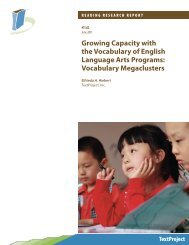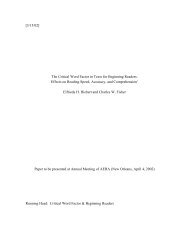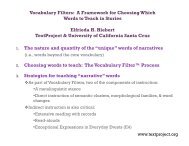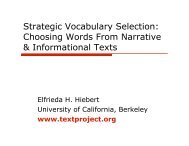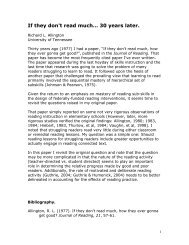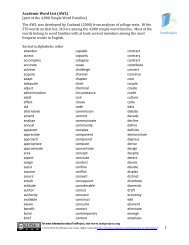Aligning Theory and Assessment of Reading Fluency - Wiley Online ...
Aligning Theory and Assessment of Reading Fluency - Wiley Online ...
Aligning Theory and Assessment of Reading Fluency - Wiley Online ...
Create successful ePaper yourself
Turn your PDF publications into a flip-book with our unique Google optimized e-Paper software.
curriculum. We plan to use the opportunity presentedin this article to synthesize several key aspects <strong>of</strong> theresearch surrounding reading fluency, from theoreticalperspectives to the role evaluation plays in determiningpractice, with an emphasis on the work that hasoccurred since the National <strong>Reading</strong> Panel’s (NICHD,2000) report.Although there are a number <strong>of</strong> definitions <strong>of</strong> readingfluency, each <strong>of</strong> which places varying emphasis onits components, there seems to be a growing consensusthat accuracy, automaticity, <strong>and</strong> prosody all makea contribution to the construct (e.g., Hudson, Pullen,Lane, & Torgesen, 2009; Rasinski, Reutzel, Chard, &Linan-Thompson, in press). Yet the way in which thesecomponents are conceptualized, their role in readingdevelopment, <strong>and</strong> their function in reading comprehensionall have significant influence on how they aretaught <strong>and</strong> assessed. In particular, we plan to considerautomaticity <strong>and</strong> prosody in greater detail. And, whilewe do not focus on the development <strong>of</strong> accurate wordrecognition, per se, we address accuracy as part <strong>of</strong> thebroader discussion <strong>of</strong> both automaticity <strong>and</strong> fluency assessment.This decision was made in part to move awayfrom the view that reading fluency results from an improvementin the ability <strong>of</strong> students to recognize words<strong>and</strong> their component elements with increasing rapidity.Instead, we refer the reader to elegant discussions <strong>of</strong> thedevelopment <strong>of</strong> reading accuracy by Chall (1996), Ehri(1995), <strong>and</strong> Perfetti (1992).Our discussion is divided into several parts; thefirst provides theoretical perspectives on reading fluency,particularly the role <strong>of</strong> automaticity <strong>and</strong> prosodyin fluency. We then consider four definitions <strong>of</strong> fluentreading; each definition places differing emphasis onfluency’s component parts as well as on the role fluencyplays in the reading curriculum. As part <strong>of</strong> thesedefinitions, we also present our own conception <strong>of</strong> whatconstitutes fluent reading. Next, we explore the relationshipbetween certain conceptualizations <strong>of</strong> readingfluency, dominant assessments, <strong>and</strong> current practice.Finally, we consider the implications <strong>of</strong> these definitionsfor assessment <strong>and</strong> instruction <strong>and</strong> make suggestionsfor incorporating a broader underst<strong>and</strong>ing <strong>of</strong> thegoals <strong>and</strong> purposes <strong>of</strong> reading fluency within a reenvisionedliteracy curriculum.Theoretical Perspectives on <strong>Reading</strong><strong>Fluency</strong>AutomaticityAutomatic word recognition is central to the construct<strong>of</strong> fluency <strong>and</strong> fluency’s role in the comprehension<strong>of</strong> text (e.g., Samuels, 2004, 2006). But what are thequalities that make for automaticity as it relates to readingfluency? According to Logan (1997; see also Moors<strong>and</strong> DeHouwer, 2006), processes are considered to beautomatic when they possess four properties: speed,effortlessness, autonomy, <strong>and</strong> lack <strong>of</strong> conscious awareness.These properties can be considered together orseparately when determining whether a skill is automatized(Moors & DeHouwer, 2006).The first <strong>of</strong> these properties is speed, which isthought to emerge concurrently with accuracy as learnersengage in practice (Logan, 1988). As automaticitydevelops, whether in terms <strong>of</strong> reading, perceptual-motoractivities, or another skilled task, the learner’s performancenot only becomes accurate, it gets faster.However, this increase in speed is not limitless. Rather,the learning curve for these tasks follows what is knownas the power law; this “states that reaction time decreasesas a function <strong>of</strong> practice until some irreducible limitis reached. Speed increases throughout practice, butthe gains are largest early on <strong>and</strong> diminish with furtherpractice” (Logan, 1997, p. 123).In terms <strong>of</strong> connected text, the power law can beseen in Hasbrouck <strong>and</strong> Tindal’s (2006) oral reading fluencynorms; for example, between winter <strong>and</strong> spring<strong>of</strong> the first-grade year students at the 50th percentileincrease their reading rate approximately 30 correctwords per minute, whereas their peers in the eighthgrade gain only 18 correct words per minute over theentire school year <strong>and</strong> the gains for adult skilled readers,who have reached asymptote, are infinitesimal.The second attribute <strong>of</strong> automaticity is effortlessness(Logan, 1997). This refers to the sense <strong>of</strong> ease withwhich a task is performed <strong>and</strong> to the ability to carryout a second task while carrying out the first, automaticone. If a person is able to accomplish two tasks at once,then at least one <strong>of</strong> those tasks is, by necessity, automatic.In terms <strong>of</strong> fluency, effortlessness can be seen intwo ways. First, fluent readers lack a sense <strong>of</strong> strugglein recognizing most <strong>of</strong> the words they encounter in text.This effortlessness in word recognition is derived, inpart, from unitization, a process that involves collapsingsome <strong>of</strong> the sequential steps used to identify words(Cunningham, Healy, Kanengiser, Chizzick, & Willitts,1988). Slow, algorithmic sequential word identificationprocesses are seemingly replaced by a shift toward directsingle-step retrieval <strong>of</strong> larger units (such as words<strong>and</strong> phrases) in long-term memory. These retrievedskills essentially outpace the slower algorithmic wordidentification processes <strong>and</strong> can be completed morequickly (Logan, 1988). Second, most fluent readers notonly decode text, but also simultaneously comprehendwhat they are reading. Inefficient word recognitionhampers comprehension <strong>and</strong> takes up precious cognitiveresources that should be used for underst<strong>and</strong>ing.With automatization <strong>of</strong> lower level processes, readers<strong>Aligning</strong> <strong>Theory</strong> <strong>and</strong> <strong>Assessment</strong> <strong>of</strong> <strong>Reading</strong> <strong>Fluency</strong>: Automaticity, Prosody, <strong>and</strong> Definitions <strong>of</strong> <strong>Fluency</strong> 231





